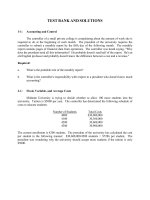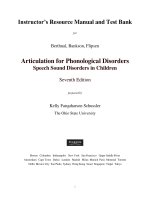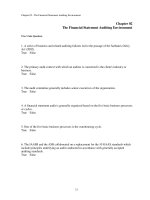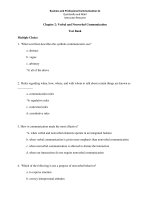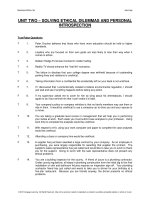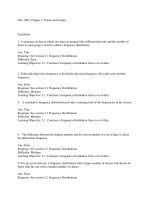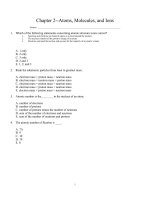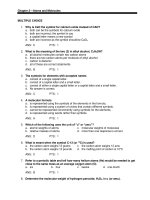Math and science for young children 8th edition charlesworth test bank
Bạn đang xem bản rút gọn của tài liệu. Xem và tải ngay bản đầy đủ của tài liệu tại đây (155.14 KB, 6 trang )
1. Webbing is useful in unit planning because it
a. is used in language arts.
b. helps organize your thoughts.
c. develops concepts in young children.
d. meets school district directives.
ANSWER:
b
LEARNING OBJECTIVES: MS.CHAR.08.02.03 - Assess, plan, teach, and evaluate science instruction in line with
national standards.
NATIONAL STANDARDS: United States - NAEYC.05c - Design, implement, and evaluate developmentally meaningful
and challenging curriculum for each child.
KEYWORDS:
Bloom’s Taxonomy: Understanding
2. Which of the following is not a basic lesson plan component?
a. Object
b. Concept
c. Materials
d. Goals
ANSWER:
d
LEARNING OBJECTIVES: MS.CHAR.08.02.03 - Assess, plan, teach, and evaluate science instruction in line with
national standards.
NATIONAL STANDARDS: United States - NAEYC.05c - Design, implement, and evaluate developmentally meaningful
and challenging curriculum for each child.
KEYWORDS:
Bloom’s Taxonomy: Understanding
3. In what way does a science teaching plan differ from a science resource file?
a. It uses local resources and free materials.
b. It presents clearly stated objectives.
c. It is intended for a specific class.
d. It contains few provisions for subject integration.
ANSWER:
c
LEARNING OBJECTIVES: MS.CHAR.08.02.03 - Assess, plan, teach, and evaluate science instruction in line with
national standards.
NATIONAL STANDARDS: United States - NAEYC.05c - Design, implement, and evaluate developmentally meaningful
and challenging curriculum for each child.
KEYWORDS:
Bloom’s Taxonomy: Understanding
4. Yes/no student responses are likely
a. with narrow questions.
b. with open-ended questions.
c. during initiating activities.
d. during observational activities.
ANSWER:
a
LEARNING OBJECTIVES: MS.CHAR.08.02.03 - Assess, plan, teach, and evaluate science instruction in line with
national standards.
NATIONAL STANDARDS: United States - NAEYC.05c - Design, implement, and evaluate developmentally meaningful
and challenging curriculum for each child.
KEYWORDS:
Bloom’s Taxonomy: Understanding
5. Which of the following describes the personal learning style?
a. Visual
b. Auditory
c. Work alone
d. All of the above
ANSWER:
d
LEARNING OBJECTIVES: MS.CHAR.08.02.03 - Assess, plan, teach, and evaluate science instruction in line with
national standards.
NATIONAL STANDARDS: United States - NAEYC.05c - Design, implement, and evaluate developmentally meaningful
and challenging curriculum for each child.
KEYWORDS:
Bloom’s Taxonomy: Understanding
6. After assessing your students, what question should you ask as you start organizing for teaching?
a. What do my students know about this science topic?
b. What is the appropriate science content that my students need to know?
c. What do my students want to know about this science topic?
d. None of these answers
ANSWER:
b
LEARNING OBJECTIVES: MS.CHAR.08.02.03 - Assess, plan, teach, and evaluate science instruction in line with
national standards.
NATIONAL STANDARDS: United States - NAEYC-03a - Understand the goals, benefits and uses of assessment.
KEYWORDS:
Bloom’s Taxonomy: Understanding
7. Which of the following is the best way for preschool- and primary-age children to show their knowledge and
understanding of a concept?
a. Explain, predict, show, tell
b. Draw, describe, construct
c. Explain, predict, show, tell and draw, describe, construct
d. None of these answers
ANSWER:
c
LEARNING OBJECTIVES: MS.CHAR.08.02.03 - Assess, plan, teach, and evaluate science instruction in line with
national standards.
NATIONAL STANDARDS: United States - NAEYC-03b - Use a variety of appropriate assessment tools and approaches.
KEYWORDS:
Bloom’s Taxonomy: Understanding
8. Children are more likely to retain concepts if they are presented in a variety of ways and extended over a period of time
a. True
b. False
ANSWER:
True
LEARNING OBJECTIVES: MS.CHAR.08.02.03 - Assess, plan, teach, and evaluate science instruction in line with
national standards.
NATIONAL STANDARDS: United States - NAEYC.05c - Design, implement, and evaluate developmentally meaningful
and challenging curriculum for each child.
KEYWORDS:
Bloom’s Taxonomy: Understanding
9. Very young children have not developed definite patterns in which they learn.
a. True
b. False
ANSWER:
False
LEARNING OBJECTIVES: MS.CHAR.08.02.03 - Assess, plan, teach, and evaluate science instruction in line with
national standards.
NATIONAL STANDARDS: United States - NAEYC.05c - Design, implement, and evaluate developmentally meaningful
and challenging curriculum for each child.
KEYWORDS:
Bloom’s Taxonomy: Understanding
10. A web depicts a variety of possible concepts and curricular experiences.
a. True
b. False
ANSWER:
True
LEARNING OBJECTIVES: MS.CHAR.08.02.03 - Assess, plan, teach, and evaluate science instruction in line with
national standards.
NATIONAL STANDARDS: United States - NAEYC.05c - Design, implement, and evaluate developmentally meaningful
and challenging curriculum for each child.
KEYWORDS:
Bloom’s Taxonomy: Understanding
11. Preschool- and primary-age children will not be able to verbalize their true understanding of a concept.
a. True
b. False
ANSWER:
True
LEARNING OBJECTIVES: MS.CHAR.08.02.03 - Assess, plan, teach, and evaluate science instruction in line with
national standards.
NATIONAL STANDARDS: United States - NAEYC.05c - Design, implement, and evaluate developmentally meaningful
and challenging curriculum for each child.
KEYWORDS:
Bloom’s Taxonomy: Understanding
12. A webbed unit is the short-term unit.
a. True
b. False
ANSWER:
False
LEARNING OBJECTIVES: MS.CHAR.08.02.03 - Assess, plan, teach, and evaluate science instruction in line with
national standards.
NATIONAL STANDARDS: United States - NAEYC.05c - Design, implement, and evaluate developmentally meaningful
and challenging curriculum for each child.
KEYWORDS:
Bloom’s Taxonomy: Understanding
13. To teach a lesson effectively you must plan for assessment.
a. True
b. False
ANSWER:
True
LEARNING OBJECTIVES: MS.CHAR.08.02.03 - Assess, plan, teach, and evaluate science instruction in line with
national standards.
NATIONAL STANDARDS: United States - NAEYC-03a - Understand the goals, benefits and uses of assessment.
KEYWORDS:
Bloom’s Taxonomy: Understanding
14. Ongoing assessment of your own teaching is to be done at the end of each year.
a. True
b. False
ANSWER:
False
LEARNING OBJECTIVES: MS.CHAR.08.02.03 - Assess, plan, teach, and evaluate science instruction in line with
national standards.
NATIONAL STANDARDS: United States - NAEYC-03c - Understand and practice responsible assessment.
KEYWORDS:
Bloom’s Taxonomy: Understanding
15. Reflect on and evaluate your unit plan before you begin teaching the unit.
a. True
b. False
ANSWER:
True
LEARNING OBJECTIVES: MS.CHAR.08.02.03 - Assess, plan, teach, and evaluate science instruction in line with
national standards.
NATIONAL STANDARDS: United States - NAEYC-03c - Understand and practice responsible assessment.
KEYWORDS:
Bloom’s Taxonomy: Understanding
Match each item with the correct statement below.
a. webbing
d.
b. goals
e.
c. objectives
lesson plan
performance-based assessment
16. State how you plan to achieve your goals
ANSWER:
c
LEARNING OBJECTIVES: MS.CHAR.08.02.03 - Assess, plan, teach, and evaluate science instruction in line with
national standards.
NATIONAL STANDARDS: United States - NAEYC-03c - Understand and practice responsible assessment.
KEYWORDS:
Bloom’s Taxonomy: Understanding
17. A technique that helps organize your thoughts
ANSWER:
a
LEARNING OBJECTIVES: MS.CHAR.08.02.03 - Assess, plan, teach, and evaluate science instruction in line with
national standards.
NATIONAL STANDARDS: United States - NAEYC-03c - Understand and practice responsible assessment.
KEYWORDS:
Bloom’s Taxonomy: Understanding
18. Giving students a task to do that will indicate their level of understanding of science concepts and thinking skills
ANSWER:
e
LEARNING OBJECTIVES: MS.CHAR.08.02.03 - Assess, plan, teach, and evaluate science instruction in line with
national standards.
NATIONAL STANDARDS: United States - NAEYC-03c - Understand and practice responsible assessment.
KEYWORDS:
Bloom’s Taxonomy: Understanding
19. Broad statements that indicate the outcomes you want to achieve
ANSWER:
b
LEARNING OBJECTIVES: MS.CHAR.08.02.03 - Assess, plan, teach, and evaluate science instruction in line with
national standards.
NATIONAL STANDARDS: United States - NAEYC-03c - Understand and practice responsible assessment.
KEYWORDS:
Bloom’s Taxonomy: Understanding
20. Helps plan the experiences that will aid in the concept development
ANSWER:
d
LEARNING OBJECTIVES: MS.CHAR.08.02.03 - Assess, plan, teach, and evaluate science instruction in line with
national standards.
NATIONAL STANDARDS: United States - NAEYC-03c - Understand and practice responsible assessment.
KEYWORDS:
Bloom’s Taxonomy: Understanding
21. _________________________ are examples of individual student work that indicate progress, improvement, and
accomplishments.
ANSWER:
Portfolios
LEARNING OBJECTIVES: MS.CHAR.08.02.03 - Assess, plan, teach, and evaluate science instruction in line with
national standards.
NATIONAL STANDARDS: United States - NAEYC-03c - Understand and practice responsible assessment.
KEYWORDS:
Bloom’s Taxonomy: Understanding
22. Observations that are written down in an organized way are called _________________________.
ANSWER:
anecdotal records
LEARNING OBJECTIVES: MS.CHAR.08.02.03 - Assess, plan, teach, and evaluate science instruction in line with
national standards.
NATIONAL STANDARDS: United States - NAEYC-03c - Understand and practice responsible assessment.
KEYWORDS:
Bloom’s Taxonomy: Understanding
23. A(n) _________________________ is an extensive collection of activities and suggestions that focus on a single
science topic.
ANSWER:
resource file
LEARNING OBJECTIVES: MS.CHAR.08.02.03 - Assess, plan, teach, and evaluate science instruction in line with
national standards.
NATIONAL STANDARDS: United States - NAEYC.05c - Design, implement, and evaluate developmentally meaningful
and challenging curriculum for each child.
KEYWORDS:
Bloom’s Taxonomy: Understanding
24. A(n) _________________________ is used to develop a science concept, objectives, materials, activities, and
evaluation procedures for a specific group of children.
ANSWER:
teaching plan
LEARNING OBJECTIVES: MS.CHAR.08.02.03 - Assess, plan, teach, and evaluate science instruction in line with
national standards.
NATIONAL STANDARDS: United States - NAEYC.05c - Design, implement, and evaluate developmentally meaningful
and challenging curriculum for each child.
KEYWORDS:
Bloom’s Taxonomy: Understanding
25. A(n) _________________________ is used to extend the information in the textbook by adding learning activities for
concepts not included in the text or in substitution for those in the text.
ANSWER:
textbook unit
LEARNING OBJECTIVES: MS.CHAR.08.02.03 - Assess, plan, teach, and evaluate science instruction in line with
national standards.
NATIONAL STANDARDS: United States - NAEYC.05c - Design, implement, and evaluate developmentally meaningful
KEYWORDS:
and challenging curriculum for each child.
Bloom’s Taxonomy: Understanding
26. ______________________________ stimulate discussion and offer opportunities for thinking.
ANSWER:
Open-ended questions
LEARNING OBJECTIVES: MS.CHAR.08.02.03 - Assess, plan, teach, and evaluate science instruction in line with
national standards.
NATIONAL STANDARDS: United States - NAEYC.05c - Design, implement, and evaluate developmentally meaningful
and challenging curriculum for each child.
KEYWORDS:
Bloom’s Taxonomy: Understanding
